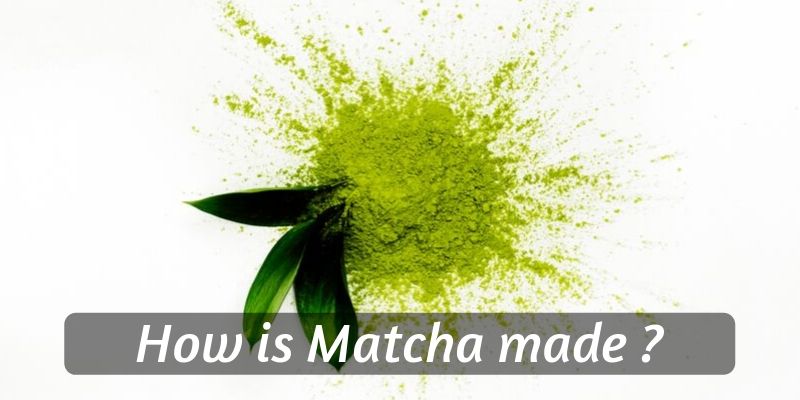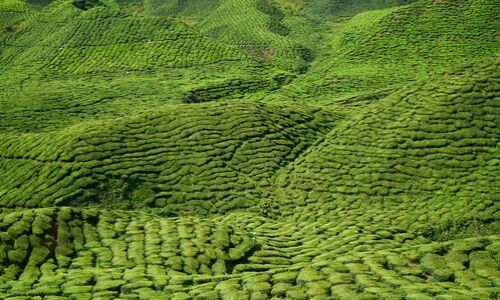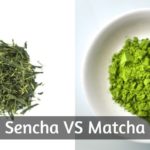Matcha is the trendiest health drink out there, and wanting to know how it's made is a reasonable thought. After all, we all want to know what we're really eating and drinking.
Which is why this guide on Matcha production process is going to sort out all your questions. We're going to touch on how Matcha is made from growing the plant to packaging the tea powder.

Table of Contents
So how is Matcha made ?
Matcha is the tea powder made from the leaves of the Camellia sinensis plant, as all true teas are. These leaves are specially grown, in gradual darkness to they produce a very specific flavor and color, which is what gives Matcha its signature taste.
Matcha leaves are grown in very specific conditions, then after picking are steamed to preserve color and nutrients. They are then deveined and the stems are removed, and finally dried.
The dried leaves are then ground into a very fine, talc-like powder that is Matcha tea.
This entire process is very specific in what must be done and when, and how. It's both time consuming and labor intensive, which makes a cup of Matcha that much more valuable.
Where does Matcha grow ?
You'll find most Matcha comes from the province of Uji. This is close to Kyoto, which is the old capital of Japan. Kyoto is where you'll find all the ancient and medieval parts of Japan, in a very well preserved state.
It's also the cultural center of Japan, and tea is at the base of it all. The region near Kyoto, especially Uji, is considered by many as the best area to grow tea. And especially tea meant to become Matcha.
This is because it's lies in an elevated area, and it's got near-perfect weather conditions. And also because it's right in the old heart of Japan, where tea has been grown for centuries and the skill has been perfected to the point of becoming an art.
There's other parts of Japan that grow tea for Matcha, but they're less well known.
Let's take a much closer look at how Matcha is made, so we can follow along step by step.
Matcha production process
The entire process starts with the plant. The tea plant is grown all year round, but there differences between each harvest season.
For example there can be as much as 4 harvests throughout the year, but each picking after the first is gradually lower in quality.
The plant produces less nutrient leaves as the year progresses and the weather changes. This results in a distinct difference between Matcha made from the first harvest, and one made even from the second.
So, the Best Matcha is the first harvest Matcha. This is usually done in the beginning of May, and until then the plant must be tended to. This is where Matcha's journey begins, and where we'll be picking up.
1. Matcha is grown in shaded and protected conditions
It takes about 3-4 weeks for the leaves meant for Matcha to bud and grow to the required 'age'. They're meant to be very supple and fine leaves, so they need to be protected from the sun.
However you can't grow a tea plant in complete darkness from the beginning, meaning that as the days go by and the new growth (for Matcha) begins to sprout on the top of the plant, it's gradually shaded.
All this happens so the flavor of Matcha reaches a desirable point. The overproduction of aminoacids results in a deep, umami flavor with a sweet aftertaste and no bitterness.
This is the plant's natural response to the lack of direct sunlight, and it's trying in its own way to compensate.
So over the course of about 3-4 weeks the tea leaves meant for Matcha are grown in more and more darkness, until they're almost completely covered.
2. Leaves for Matcha are supple, very fragile
By the time harvest time rolls around the leaves of the tea plant should be bright, bright green and be soft to the touch. This is something that sets them apart from tea leaves meant for other teas.
All new growth is soft and supple, but shade-grown tea is especially soft.
The topmost parts of the tea plant are then harvested. They're almost always hand picked, since you need a good eye to pluck the two leaves necessary for Matcha.
This, combined with the relatively low yield of the tea plant results in many plants having to be picked for just a few leaves each harvest. In comparison with plants being almost fully picked when regular tea is made.
Not all leave are good enough for Matcha, and this means that some leaves are plucked but not used for Matcha. Instead, they end up as another premium tea, and I'll get to that in a bit.
3. The leaves are processed to become Tencha
Once the leaves are picked, they are steamed to preserve their color, and to prevent any sort of oxidation. This means that the tea won't have any bitterness, and it won't change its flavor over time.
Steaming, as opposed to pan-firing, results in a gentler way of preserving the flavor and nutrients. As in, exposing them to heat to lock them in, but hot too high heat so they change.
There's also a natural process that happens when any sort of plant or vegetable is steamed. Very much like culinary blanching, steaming brightens the color of the item. Actively boiling it reduces the color and dulls it.
So for Matcha, which is a tea famous for its bright green color, steaming is an essential step.
After steaming, the leaves are allowed to cool a little and dry out.
At this point, the leaves can go in two directions - remain whole, and become Tencha and later Gyokuro, or go to the next processing step and become Matcha.
For Matcha, the next step after drying is to very carefully remove all the veins and stems in the tea leaves.
This is time consuming, but necessary when trying to achieve a very smooth and uniform flavor. So all the large, rough veins and stems are removed from each individual tea leaf.
It also makes grinding the leaves much easier, since all pieces are of the same size, so the grinder produces an uniform powder at the end.
Some leaves end up as Gyokuro tea
We should touch a bit on Gyokuro as well. If the leaves are not deveined and destemmed, they are known as Tencha. This tea is then rolled lightly, and becomes Gyokuro.
This is the best possible green tea you can find in Japan, or of Japanese origin. It's the green tea that actually produces a light green hue when brewed, due to being steamed and not pan-fired.
Gyokuro tea is less known than Matcha on the Western market, but it's one of the purest green teas out there in terms of flavor. It's the closest you can get to the raw flavor of green tea.
4. Tencha is very slowly and finely ground into Matcha
Once the Techa (deveined and destemmed leaves) is ready, it's then broken up into smaller pieces. Those pieces are then very slowly and carefully ground.
The mill uses a granite grinding stone, to have the best possible surface for evenly and smoothly grinding out any bit of tea leaf.
Also, a lot of heat tends to get produced when grinding. The stones can become hot, so the mill must work at a slow pace. If the tea were to be exposed to any heat now, the flavor would change.
So it can take up to an hour to grind about 30 grams/1 oz of Matcha powder. A whole hour.
Lots of labor goes into making Matcha, but it's all worth it in the end.
5. Matcha powder is stored and shipped
Once the grinding is done and the powder is fine enough, the Matcha is done.
The final product should be a very light, very talc-like powder. Bright green with a faint grassy scent.
At this point, Matcha is very sensitive. It needs to be stored in a cool, dry place away from direct sunlight and any humidity since it can lose its flavor and nutrients very quickly.
Usually Matcha gets packaged and is ready for shipping right after this step.
Matcha grades vary greatly
Not all Matcha is made the same. The process I described above is the process normally used, but the leaves are so very important.
Older leaves - harvests later in the year - or those that have not been properly shaded produce the lower grade Matcha you will see used in foods and drinks.
For example Matcha latte is most often made using a lower grade of Matcha, since it's cheaper and you won't really know the difference due to the milk and sugar added.
So let's go over the 3 types of Matcha you'll find on the market, so you can tell them apart. Keep in mind that the difference between each grade is somewhat subjective.
There is no very clear or definite set of rules as to how each batch is graded, it's more of an opinion and what for some might be culinary grade for others might be premium.
1. Culinary grade Matcha is the most common
Culinary Matcha, or food grade, is the cheapest and most easily available Matcha possible. It's usually more of a sandy texture than premium and ceremonial Matcha. This is because the leaves used are second or third harvest, or from lower on the plant.
It's usually slightly bitter, and this could be a result of not being properly shaded, along with using lower quality leaves.
You'll also notice a duller shade of green, as opposed tot he bright green of a good Matcha.
The name of this grade comes from the uses it normally takes. You'll find it in food such as cakes, ice cream, or pastries, and in drinks such as lattes or milkshakes.
You might also find it in iced tea, since it's usually sweetened.
All this being said, don't steer too clear away from something labeled culinary grade Matcha. Some companies might have disagreeing opinions as to just how good or poor their Matcha is, and end up labeling a perfectly good premium as a culinary grade.
2. Premium grade Matcha is the first flavorful grade
This is the grade of Matcha most coffee and tea houses use for their actual cups of Matcha. More expensive than food grade, less expensive than ceremonial (somewhat).
When whipped, the Matcha should be thick and frothy, as opposed to culinary grade where you might not always get the most foam/crema from the powder.
The texture is very different, as it should be noticeable softer, with no grit. The color is already bright green, and the taste is different as well.
You'll notice the umami and a bit of sweetness as an aftertaste, but it's not as pronounced as ceremonial grade.
Still a large improvement over culinary grade.
3. Ceremonial grade is the best Matcha, and most expensive
Ceremonial grade Matcha is the most expensive grade there is, and also the best. It ends up as a cup of thick, creamy, uniform Matcha with a nice and smooth finish.
There should be no bitterness at all, and the sweetness should be definitely there. It's more of a sweetness like milk or butter, the kind hat makes you want to have another cup.
The froth should be very thick, and the color of the drink and the powder as green as your eyes can bear it.
To be honest the difference between premium and ceremonial is often a bit blurry. You might find something of a weaker quality labeled as ceremonial, when in fact it's a premium.
But really all 3 grades are more of a scale, with some batches being closer to a culinary but not really there, or some nearly ceremonial.
Conclusion
Hopefully this explanation of how Matcha is made and how this all results in several grades when it comes to quality will answer all your questions.
You should know that not all Matcha is the same, and even if culinary grade is a lower quality it might suit a smoothie or health drink just as good as any other grade.
Try them all out, when you have the chance. After all, a lot of work went into making each batch of Matcha and you're bound to find your favorite.
If you want to know more about coffee or tea, feel free to check the related articles below. Who knows what else you might find ?






